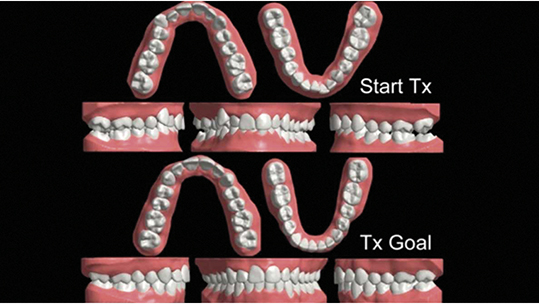CLEAR ALIGNER THERAPY: BEGIN WITH THE END IN MIND Leave a comment
Ricketts and Bench developed and promoted the Visual Treatment Objective, or VTO, as a technique to create that visualization.
Today, the emergence of clear aligners as an accepted modality for orthodontic treatment has brought us the digital VTO in the form of a treatment setup. Once the software technician has manipulated the original digital models to represent a satisfactory treatment goal, not only is the new occlusion visualized but the sequential pathway from beginning to end animates how the teeth will move to arrive at their destination.
This is precisely what the Diagnostic wax-up is all about whether it is digital or analogue. With the digital model the experienced technician can virtually create the desired result but with the advantage of recognising whether it is right or wrong. The inherent 3D vision of a well-trained technician is part of the job. Having a supportive clinical awareness and knowledge makes the outcome much more secure. Good communication and understanding of the clinician’s choices and desires for the patient, is essential but not always available. Anyone who has moved teeth with clear aligners understands just how important it is for the clinician to master the nuances of the treatment setup. This mastery begins with the information and direction the clinician provides the technician before the software moves a single tooth.
Many of the computer driven processes are often just making sure the information, often missing in day to day dentistry, is included in the software package. The computer programmer has the advantages of access to the technical knowledge as well as the clinical requirements and combines the two from the beginning of the treatment planning. Strangely the better the computer software combines these essential groups of knowledge the more attractive it becomes. Yet it just underlines the essential for good communication between clinic and laboratory. Software packages such as ClearCorrect or Invisalign are often lauded because they automatically combine the necessary knowledge as part of their software.
As with the traditional method of Diagnostic Wax-up or Set-up the clinician’s judgement as to the suitability of the proposed corrections or changes is paramount. Once the original treatment setup is completed, the doctor must approve it to say it is right and will bring the result for the patient. Does it meet the clinician’s objectives for occlusion, interdigitation, appropriate tooth relationship? Will it provide the overbite and overjet, rotation correction, staging of treatment time and facial aesthetics? If the criteria are met, the setup is approved and the fabrication of the aligners begins; if the doctor rejects any part of the setup, the doctor submits his objections and instructions for correcting or improving the identified issues and the setup is revised. Within a couple of days, the review process is repeated. As would be the case with traditional methods.
The major advantage of Digital techniques is they do not charge a fee for preparing the treatment setup or even multiple setups in case the doctor would like to visualize alternative treatment plans, e.g., in borderline cases where extraction may result in a more favourable result than non-extraction. Once the clinician has invested in the intraoral scanner and the computer hard and software, they are of course able to call on the software to carry out most of their wishes. The shortcoming will be the ability of the clinician to understand the desired pathway for the end result.
As with the traditional diagnostic system showing the patient the proposed outcome will very often stimulate a more serious patient commitment to the treatment process. A big advantage of the Digital process is the inherent ability for visualisation of the process and of the proposed finished result.
BY KEN FISCHER




